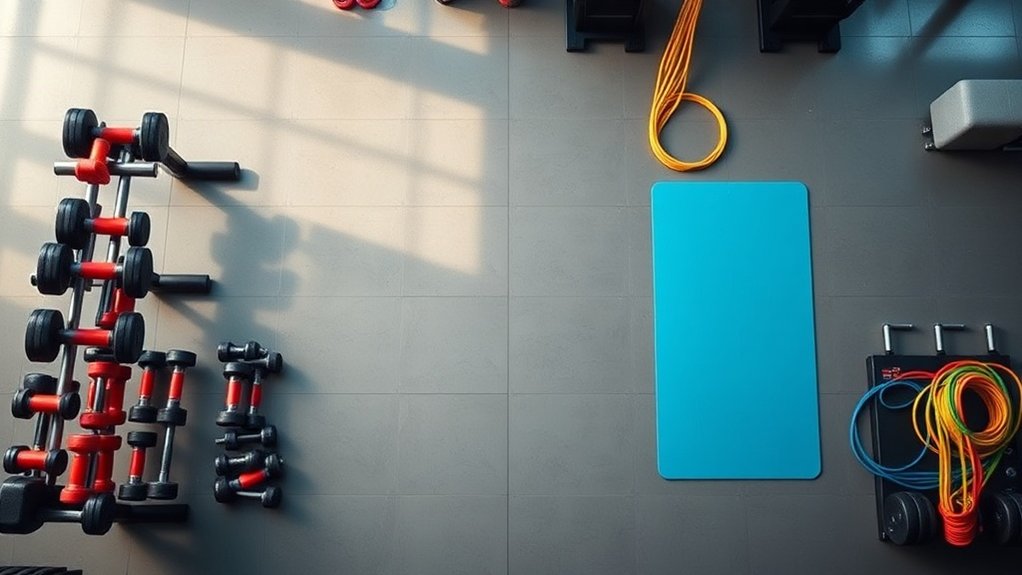You’ll train each muscle group twice weekly with this 4-day upper/lower split, dividing sessions between upper body (chest, back, shoulders, arms) and lower body (quads, hamstrings, glutes, calves). You’ll perform 3-5 sets per exercise using 6-12 reps for hypertrophy, starting with compound movements before isolation work. This approach distributes 10-20 weekly sets per muscle across multiple sessions, stimulating protein synthesis more frequently while allowing 48-72 hours recovery between training the same muscles. The structure below reveals how to optimize exercise selection, progression strategies, and program templates for your specific goals.
What Is the Upper/Lower Personalized Split?

The Upper/Lower Personalized Split divides your training week into four distinct sessions: two targeting upper body musculature and two focusing on lower body development.
This workout routine systematically trains your chest, back, shoulders, and arms during upper sessions, while lower sessions address your quads, hamstrings, glutes, and calves.
You’ll train each muscle group twice weekly, which research demonstrates superior effectiveness for muscle growth compared to once-weekly training.
The split’s structure accommodates your recovery capacity and scheduling constraints, making it practical whether you’re an intermediate or advanced lifter.
The “personalized” component matters: you can adjust exercise selection, volume, and intensity based on your specific goals and fitness level.
This customization guarantees your Upper/Lower Split aligns with your individual needs rather than following a generic template.
The Science Behind 4-Day Upper/Lower Training Frequency
Multiple studies confirm that twice-weekly training frequency produces superior muscle growth compared to single-session protocols.
When you train each muscle group twice per week using an upper/lower split, you’re creating ideal conditions for hypertrophy while managing recovery demands effectively.
This training frequency works because it allows you to distribute volume across multiple sessions rather than cramming everything into one exhausting workout. You’ll stimulate protein synthesis more frequently throughout the week, which research shows improves overall gains.
The 4-day structure combines compound movements with targeted isolation exercises, maximizing both strength and muscle development.
Whether you’re intermediate or advanced, this approach adapts to your recovery capacity.
Progressive overload remains essential—you must consistently increase weights or repetitions to continue improving your physique and performance.
Benefits of the Upper/Lower Split for Strength and Hypertrophy

When you implement an upper/lower split into your training program, you’ll reveal distinct advantages for both strength and hypertrophy that traditional body-part splits can’t match.
The improved training frequency allows each muscle group to be stimulated twice weekly, creating superior conditions for muscle hypertrophy compared to once-per-week approaches.
Key benefits you’ll experience:
- Optimal Recovery Patterns – Alternating between upper and lower sessions prevents overlapping muscle fatigue while maintaining high training frequency.
- Progressive Overload Integration – The structure naturally supports systematic increases in weight and volume, essential for continued strength gains.
- Varied Rep Range Application – You can implement both strength-focused (5-8 reps) and hypertrophy-targeted (8-12 reps) ranges throughout the week.
Research consistently demonstrates that this upper/lower split methodology produces superior muscle mass and strength improvements compared to traditional splits.
Optimal Exercise Selection for Upper Body Days
When designing your upper body days, you’ll need to strategically balance compound movements like bench presses and rows with isolation exercises such as bicep curls to maximize both strength and hypertrophy.
The sequence in which you perform these exercises directly impacts your performance—placing multi-joint movements first when you’re fresh allows you to handle heavier loads and stimulate greater muscle adaptation.
Distributing adequate training volume across each muscle group, typically 3-5 sets per exercise within the 6-12 rep range, guarantees you’re providing sufficient mechanical tension for growth without compromising recovery.
Compound vs. Isolation Movements
Your upper body training demands a strategic balance between compound movements and isolation exercises to maximize both strength gains and muscle development.
Compound movements like bench presses and rows engage multiple muscle groups simultaneously, allowing you to lift heavier loads and create greater mechanical tension for hypertrophy.
Meanwhile, isolation exercises target specific muscles that need additional attention.
Structure your upper body workouts with:
- 2-3 compound movements performed for 3-5 sets of 6-8 reps at challenging weights
- 1-2 isolation exercises executed for 2-4 sets of 10-15 reps to improve muscle endurance
- Priority placement of compound exercises first when you’re freshest for ideal strength development
This evidence-based approach improves functional strength while confirming thorough muscle development across your entire upper body.
Exercise Order and Sequencing
Beyond selecting the right exercise types, the sequence in which you perform them directly impacts your strength output and muscle-building results.
On upper body days, you’ll maximize performance by starting with compound movements like bench press or overhead press when your energy is highest. These multi-joint exercises allow you to lift heavier loads and stimulate more overall muscle growth.
Next, incorporate horizontal and vertical pulling movements such as bent-over rows or pull-ups to balance your pushing work. Save isolation exercises like bicep curls and tricep extensions for the end of your session.
This exercise order prevents smaller muscles from limiting your compound lift performance. Alternate between pushing and pulling movements throughout your sequencing to maintain muscle balance while managing fatigue effectively.
Volume Per Muscle Group
Strategically distributing training volume across muscle groups determines whether your upper body days produce balanced development or create structural imbalances.
Your upper lower split requires precise volume allocation during training sessions to maximize hypertrophy while preventing overtraining.
For ideal volume per muscle group, structure your upper days with:
- Chest and Back Priority: Include 6-8 sets each (2 exercises × 3-4 sets), emphasizing compound movements like bench presses and bent-over rows to build foundational strength.
- Moderate Shoulder Volume: Perform 3-4 sets (1 exercise) targeting deltoids without compromising recovery.
- Arm Finishers: Allocate 3-4 sets each for biceps and triceps through focused isolation work.
This distribution guarantees balanced development across all major upper body muscles while maintaining sustainable training frequency.
Implement supersets between antagonistic muscle groups to improve efficiency without compromising volume quality.
Optimal Exercise Selection for Lower Body Days
When designing lower body training days within a 4-day split, you’ll need to select exercises that systematically target all major muscle groups of the legs and hips.
Your lower body workouts should include 1-2 quadriceps-focused movements like squats or leg presses for front thigh development. Balance this with 1-2 hamstring exercises such as deadlifts or leg curls to prevent muscular imbalances and reduce injury risk.
Exercise selection must prioritize glute activation through compound movements like hip thrusts or glute bridges, which improve overall lower body strength.
Don’t overlook your calves—incorporate 1-2 sets of standing or seated calf raises for complete lower leg development.
Additionally, integrate core exercises like planks or Russian twists alongside your lower body work, as they’ll provide the stability necessary for peak performance in compound movements.
Training Volume and Intensity Recommendations Per Session

Your training volume and intensity directly determine whether you’ll build muscle effectively or waste time in the gym.
Each session requires carefully calibrated sets per muscle group, specific rep ranges that trigger hypertrophy, and strategic rest periods that allow you to maintain performance across all working sets.
Let’s examine the precise numbers you need to structure each upper and lower body workout for ideal results.
Optimal Sets Per Muscle
Understanding the ideal training volume for each muscle group forms the foundation of an effective 4-day workout split. Your best training approach should target 10-20 sets per muscle weekly, distributed across your sessions based on recovery capacity and experience level.
For each workout routine, implement this evidence-based framework:
- 3-5 sets per muscle per session – This allows adequate stimulus without exceeding recovery limits in your 4-day split.
- 6-12 rep ranges – Target this hypertrophy-focused zone for maximum muscle growth.
- Progressive overload application – Increase weight or reps when you’ve consistently completed all sets at your target range’s upper end.
Your sets per muscle should align with compound versus isolation exercises: rest 1-3 minutes between heavy compounds, 30-90 seconds for isolations.
Monitor volume and intensity consistently to prevent plateaus.
Rep Ranges For Growth
Although training volume establishes your weekly stimulus, rep ranges determine the specific intensity and metabolic stress you’ll apply during each session of your 4-day split.
You’ll maximize muscle growth by performing 6-12 reps per set for most exercises, completing 3-5 sets per movement. If you’re advanced, you can increase training volume to 4-6 sets of 8-12 reps while maintaining sufficient load.
Target 10-20 total weekly sets per muscle group, distributed across your two upper and two lower sessions.
You’ll stimulate different muscle fibers by incorporating both compound movements (6-10 reps) and isolation exercises (10-15 reps).
Apply progressive overload by increasing weight or reps when you reach your rep range’s upper limit—this continual advancement drives adaptation and growth.
Rest Periods Between Sets
Strategic rest intervals between sets directly influence your recovery capacity, training performance, and overall muscle-building results within your 4-day split.
Your rest periods should align with exercise selection and training goals. Compound movements demand longer recovery windows, while isolation exercises require less time between sets to maintain workout efficiency.
Optimal Rest Period Guidelines:
- Compound exercises: Take 3-5 minutes between sets to maximize strength output and guarantee complete ATP-PC system restoration for heavy squats, deadlifts, and presses.
- Isolation exercises: Rest 1-2 minutes between sets to sustain training intensity while promoting muscular endurance during bicep curls, lateral raises, and leg extensions.
- Volume considerations: Execute 3-4 sets of 8-12 reps with consistent rest tracking to identify fatigue patterns and optimize your recovery strategies throughout each session.
Upper/Lower Vs Full-Body Vs Body-Part Split Comparison

When choosing a training split for your 4-day workout plan, you’ll encounter three primary approaches: Upper/Lower, Full-Body, and Body-Part splits.
The Upper/Lower split trains each muscle group twice weekly, optimizing frequency for muscle growth while maintaining manageable session durations. Full-Body workouts target all major muscles per session, benefiting beginners but potentially causing excessive fatigue in 4-day programs.
Body-Part splits isolate one or two muscle groups daily, allowing high training volume but limiting frequency to once weekly per muscle.
Research demonstrates that increased training frequency, characteristic of Upper/Lower splits, boosts muscle growth compared to once-weekly protocols.
For intermediate and advanced lifters following 4-day schedules, Upper/Lower splits provide superior muscle engagement through balanced frequency, volume, and recovery.
Your choice ultimately depends on training experience and specific goals.
Who Benefits Most From 4-Day Upper/Lower Training?
You’ll get the most from a 4-day upper/lower split if you’re an intermediate to advanced lifter with at least 6-12 months of consistent training experience.
This program requires sufficient work capacity to handle training each muscle group twice weekly with adequate volume and intensity.
If you can commit to four structured training days per week while maintaining proper recovery between sessions, this split aligns perfectly with your schedule and training needs.
Intermediate to Advanced Lifters
Intermediate and advanced lifters stand to gain the most from a 4-day upper/lower split because their training demands exceed what a 3-day program can effectively deliver.
You’ve built a foundation of strength and technique, and now you need increased frequency to target muscle groups twice weekly for continued adaptation.
The 4-day upper/lower split addresses your specific needs through:
- Increased volume distribution – You’ll accumulate sufficient training volume across multiple sessions without excessive fatigue in single workouts.
- Strategic recovery optimization – Your muscles receive 48-72 hours between training the same muscle groups, promoting protein synthesis and adaptation.
- Plateau prevention mechanisms – The structured format allows you to implement periodization cycles and specialization phases while maintaining balanced development.
This approach positions intermediate to advanced lifters for sustainable progress and measurable strength gains.
Balanced Schedule Seekers
If you’re seeking a training program that integrates logically with work commitments and personal responsibilities, the 4-day upper/lower split delivers structured progression without dominating your weekly calendar.
This approach spaces training sessions strategically—typically two consecutive days followed by rest—allowing you to maintain consistent muscle growth while accommodating professional and personal obligations.
The split’s effectiveness lies in training each muscle group every 3rd or 4th day, optimizing the recovery capacity needed for strength gains without excessive time demands.
You’ll benefit from exercise variation that prevents monotony while confirming adequate recovery between sessions. This balanced frequency supports both upper and lower body development twice weekly, making it particularly valuable if you’re managing multiple life priorities while pursuing meaningful physical adaptation and performance improvements.
Progression Strategies Across Four Weekly Sessions

While strength gains may seem random at first, systematic progression strategies transform your 4-day workout plan into a predictable muscle-building machine.
Your upper/lower split demands specific techniques to maximize adaptation while respecting recovery demands.
Three Core Progression Methods:
- Linear Load Increases – Add 2.5-5 pounds once you’ve hit your target rep range (5-8 for strength, 8-12 for hypertrophy) across all sets for two consecutive sessions.
- Strategic Periodization – Cycle between 4-week phases of higher volume (more sets) and heavier loads to prevent plateaus and optimize neural adaptations.
- Exercise Variation Windows – Swap movement patterns every 4-6 weeks (barbell to dumbbell variations, grip changes) to stimulate different muscle fibers without abandoning proven lifts.
Track every session meticulously.
Your progression depends on data, not guesswork.
Complete 4-Day Upper/Lower Program Templates
Your training template determines whether you’ll spend months spinning your wheels or building measurable strength across every major movement pattern.
A proven upper/lower split structures your week with Monday and Thursday targeting chest, back, and shoulders through compound movements like bench presses and rows, while Tuesday and Friday emphasize squats, deadlifts, and posterior chain development.
This workout routine guarantees each muscle group receives 48-72 hours recovery between sessions while maintaining twice-weekly frequency for ideal muscle growth.
You’ll implement progressive overload by tracking weights and reps across all four sessions, adjusting resistance by 2-5% when you exceed target rep ranges.
Rest Wednesday and weekends, or include active recovery.
Customize exercise selection and volume based on your individual recovery capacity and strength goals.
Frequently Asked Questions
Can I Add Cardio on Rest Days Without Affecting Recovery?
You can add low-to-moderate cardio intensity on rest days without compromising recovery. Implement recovery strategies like proper nutrition and sleep to maintain workout balance. Monitor your fatigue levels and adjust accordingly to guarantee you’re not overtraining.
How Should I Adjust Nutrition on Upper Versus Lower Body Days?
You’ll want slightly higher carb intake on lower body days since leg workouts demand more glycogen. Adjust macronutrient ratios by adding 20-30g carbs to your pre workout snacks and post workout meals compared to upper days for ideal recovery.
What if I Miss a Workout During the Week?
If you miss a session, don’t double up workouts. Simply resume your next scheduled day, maintaining workout flexibility. This approach optimizes recovery strategies and prevents overtraining. Missing occasional sessions won’t derail progress when you’re consistent overall.
Can I Train Abs Every Session or Alternate Days?
You can train abs frequently, but alternating days optimizes ab training frequency by allowing core muscle recovery between sessions. This approach maintains workout intensity balance while preventing overtraining. Listen to your body’s fatigue signals for best results.
How Long Should Rest Periods Be Between Sets?
Your ideal rest period strategies depend on your goals: 2-3 minutes for compound lifts guarantees adequate set recovery, while 60-90 seconds works for isolation exercises. You’ll maximize strength and hypertrophy by following these evidence-based rest intervals consistently.



